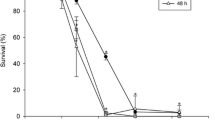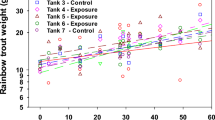Conclusions
The gills of the oyster are probably the primary entry site of DDT. The gut may be a DDT entry site also, but is of secondary importance. Further, mantle uptake of DDT has not been demonstrated. Hence, DDT found in the mantle is probably deposited there by the circulatory system after uptake across the gills. On the basis of the rapid rate of pesticide elimination from oyster tissue, the value of the oyster as an environmental integrator is questionable.
Reported solubility values for DDT range from 0.1 ug/1 to 45 ug/1 (11,12,13). Although these values are contradictory, the fact remains that DDT has an extremely low solubility in water. This low solubility, as well as a tendency for sorption on particulate matter and/or equipment employed in sample handling, may make kinetic studies with DDT and similar compounds impossible.
Similar content being viewed by others
References
V. L. Loosanoff, Fishing Gaz. 64 (4):94–96 (1947)
H. C. Davis and P. E. Chanley, Proc. Nat. Shellfisheries Assoc. 46:59–74 (1955)
G. D. Waugh and A. Ansell, Comm. Fish. Rev. 44(4): 619–625 (1956
P. A. Butler and P. F. Springer, Trans. 28th N. Amer. Wildlife Natur. Resour. Confer., p. 378–379 (1963)
P. A. Butler, Trans. 31st N. Amer. Wildlife Natur. Resour. Confer., p. 184–189 (1966)
P.A. Butler,in. The Encyclopedia of Marine Resources ed. by Prank E. Firth. Van NostrandRheinhold Co., p. 513–516 (1969)
J. W. Simpson and J. Awapara, Comp. Biochem. Physiol. 18(3):537–548 (1966)
C. Chen and J. Awapara, Comp. Biochem. Physiol. 30(4):727–737 (1969)
L. H. Jodrey and K. M. Wilbur, Biol. Bull. 108 (3):346–358 (1955)
E. J. Lund, Publ. Inst. Mar. Sci. Univ. Texas 4(2):296–312 (1957)
F. H. Babers, J. Am. Chem. Soc. 77(17):4666 (1955)
K. D. Roeder and E. A. Weiant, Science 103(2671): 304–306 (1946)
A. G. Richards and L. K. Cutkomp, Biol. Bull. 90 (2):97–108 (1946)
Author information
Authors and Affiliations
Rights and permissions
About this article
Cite this article
Brodtmann, N.V. Studies on the assimilation of l,l,l-trichloro-2,2-bis (p-chlorophenyl) ethane (DDT) byCrassostrea virginica Gmelin. Bull. Environ. Contam. Toxicol. 5, 455–462 (1970). https://doi.org/10.1007/BF01559059
Published:
Issue Date:
DOI: https://doi.org/10.1007/BF01559059




